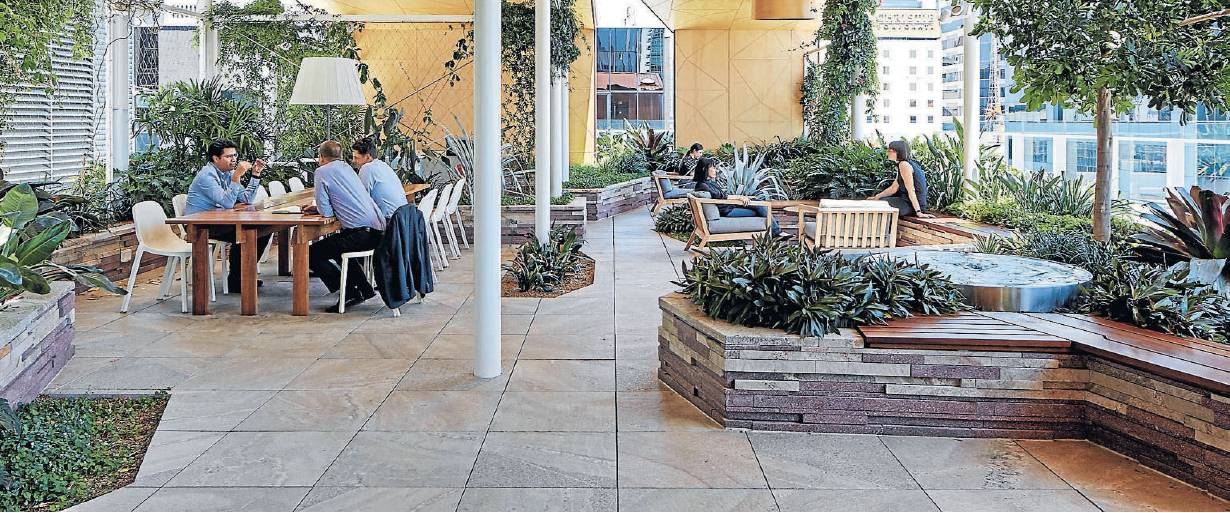Knock on wood – the way forward at work
Building designers are increasingly incorporating natural elements into indoor environments based on growing evidence associated with biophilia, the principle that connection to nature is essential to human wellbeing.
Now world-first research has revealed naturallooking wooden surfaces in the workplace are strongly associated with increased employee wellbeing and satisfaction, affording potential significant improvements to their productivity.
The new study of 1000 Australian indoor workers was conducted by strategic market research agency Pollinate for Forest and Wood Products Australia (FWPA), and further analysed by Associate Professor Jacki Schirmer of the University of Canberra.
The study showed natural-looking, sustainably sourced wood has a key role in the design of green buildings and cities.
This latest evidence is key to the business case for using wood and other elements of nature in the workplace, according to Dr Schirmer, who is addressing the Green Cities conference in Melbourne today.
“Previous studies had looked at individual elements, such as plants, and found benefits, but there had not been any research of this scale and breadth focusing on wood,” Dr Schirmer says.
“Now there is evidence for the first time that there are real and measurable benefits associated with including natural-looking wood in the workplace.
“The research was robust, and represents ground-breaking evidence that wood in the workplace is associated with better work satisfaction and wellbeing.
“That’s very important because we know from other research that better workplace satisfaction and wellbeing leads to better productivity in the form of reduced absenteeism, employees being more willing to invest in their work, and less office conflict.”
Over 80 per cent of workers (82 per cent) of workers exposed to eight or more wooden surfaces reported being ‘‘satisfied or very satisfied’’ with their work compared to half (53 per cent) with no wooden surfaces and over two thirds (69 per cent) who were exposed to between five and seven wooden surfaces.
The research results held true when controlled for factors including occupation, age, gender, income, workplace noise and workplace culture.
Employees in the study with natural wooden surfaces on average also reported higher personal productivity, mood, concentration, clarity, confidence and optimism – and were more likely to find their workplaces relaxing, calming, natural-feeling, inviting and energising.
More than two thirds of indoor workers surveyed were based in an office, with the remainder split among shops, factories and warehouses.
The study – Workplaces: Wellness + Wood = Productivity – highlighted that, on average, almost half of employees who work indoors spend less than an hour outdoors on work days.
This is of concern given the long-established connection between wellbeing and spending time in nature, especially amid the increasing urbanisation of populations.
Natural elements that can be brought indoors include materials like stone and wood, water features, plants, natural light and imagery depicting the natural world.
It’s easier to add wood to an existing workplace than some other natural design features, such as access to natural light that cannot be easily retrofitted.
In some work environments, it’s challenging to include biophilic design elements due to requirements for sterility (for instance, in operating theatres or factories) or because of design constraints (e.g. can’t install new windows in an existing building, can’t change the view).
Biophilic design stems from biophilia, meaning the love of nature, a term made popular by American psychologist Edward O. Wilson in the 1980s, when he noted how urbanisation led to a detachment from the natural world.
The principle brings into focus our innate attraction to nature and implies we all have an inherent connection to the natural world through centuries of living in agricultural settings. The common urge for a sea (or tree) change is very real.
Researchers and academic institutions are increasingly focusing on biophilia. It is, for example, now included on the civil engineering curriculum at Griffith University.
The managing director of industry services company Forest and Wood Products Australia (FWPA), Ric Sinclair, said that individual businesses, and the Australian economy as a whole, could benefit from increasing access to nature inside the workplace.
“Forest and Wood Products Australia collaborates with government, academia and industry to grow the market, delivering real-world outcomes that are good for business, the environment and society,” he said.
“We invested in this research on behalf of our members because it provides hard data supporting the use of wood, not just in terms of attractiveness and environmental benefits, but in terms of business.”
By proving the benefits associated with wood, designers who want to bring natural elements into workplaces now have an extra tool in their armoury.
Designers interested in using wood in an office setting can now consult a new WoodSolutions publication: Guide 43 Reimagining Wood-Based Office Fit-Out Systems, which showshow the average office furnishing cycle of “fit-out, strip out, repeat” can be improved.
Better workplace satisfaction and wellbeing leads to better productivity.
Jacki Schirmer
